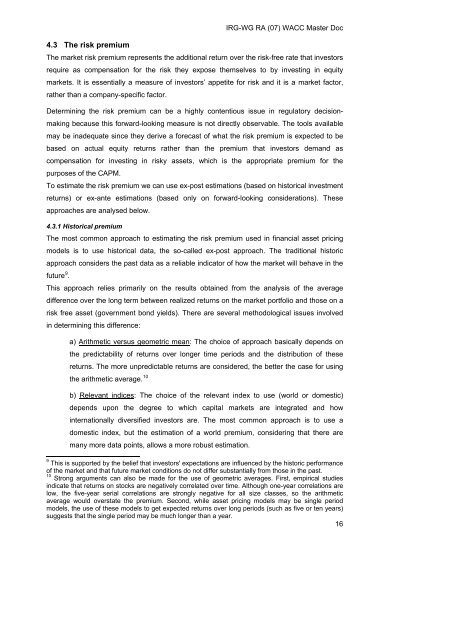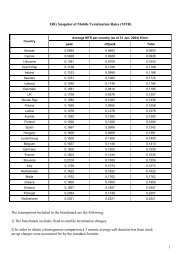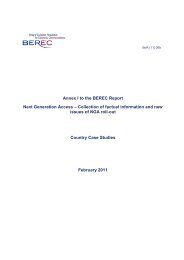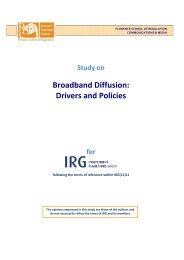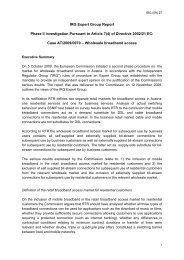Create successful ePaper yourself
Turn your PDF publications into a flip-book with our unique Google optimized e-Paper software.
4.3 The risk premium<br />
<strong>IRG</strong>-WG RA (<str<strong>on</strong>g>07</str<strong>on</strong>g>) <strong>WACC</strong> Master Doc<br />
The market risk premium represents the additi<strong>on</strong>al return over the risk-free rate that investors<br />
require as compensati<strong>on</strong> for the risk they expose themselves to by investing in equity<br />
markets. It is essentially a measure of investors’ appetite for risk and it is a market factor,<br />
rather than a company-specific factor.<br />
Determining the risk premium can be a highly c<strong>on</strong>tentious issue in regulatory decisi<strong>on</strong>making<br />
because this forward-looking measure is not directly observable. The tools available<br />
may be inadequate since they derive a forecast of what the risk premium is expected to be<br />
based <strong>on</strong> actual equity returns rather than the premium that investors demand as<br />
compensati<strong>on</strong> for investing in risky assets, which is the appropriate premium for the<br />
purposes of the CAPM.<br />
To estimate the risk premium we can use ex-post estimati<strong>on</strong>s (based <strong>on</strong> historical investment<br />
returns) or ex-ante estimati<strong>on</strong>s (based <strong>on</strong>ly <strong>on</strong> forward-looking c<strong>on</strong>siderati<strong>on</strong>s). These<br />
approaches are analysed below.<br />
4.3.1 Historical premium<br />
The most comm<strong>on</strong> approach to estimating the risk premium used in financial asset pricing<br />
models is to use historical data, the so-called ex-post approach. The traditi<strong>on</strong>al historic<br />
approach c<strong>on</strong>siders the past data as a reliable indicator of how the market will behave in the<br />
future 9 .<br />
This approach relies primarily <strong>on</strong> the results obtained from the analysis of the average<br />
difference over the l<strong>on</strong>g term between realized returns <strong>on</strong> the market portfolio and those <strong>on</strong> a<br />
risk free asset (government b<strong>on</strong>d yields). There are several methodological issues involved<br />
in determining this difference:<br />
a) Arithmetic versus geometric mean: The choice of approach basically depends <strong>on</strong><br />
the predictability of returns over l<strong>on</strong>ger time periods and the distributi<strong>on</strong> of these<br />
returns. The more unpredictable returns are c<strong>on</strong>sidered, the better the case for using<br />
the arithmetic average. 10<br />
b) Relevant indices: The choice of the relevant index to use (world or domestic)<br />
depends up<strong>on</strong> the degree to which capital markets are integrated and how<br />
internati<strong>on</strong>ally diversified investors are. The most comm<strong>on</strong> approach is to use a<br />
domestic index, but the estimati<strong>on</strong> of a world premium, c<strong>on</strong>sidering that there are<br />
many more data points, allows a more robust estimati<strong>on</strong>.<br />
9<br />
This is supported by the belief that investors' expectati<strong>on</strong>s are influenced by the historic performance<br />
of the market and that future market c<strong>on</strong>diti<strong>on</strong>s do not differ substantially from those in the past.<br />
10<br />
Str<strong>on</strong>g arguments can also be made for the use of geometric averages. First, empirical studies<br />
indicate that returns <strong>on</strong> stocks are negatively correlated over time. Although <strong>on</strong>e-year correlati<strong>on</strong>s are<br />
low, the five-year serial correlati<strong>on</strong>s are str<strong>on</strong>gly negative for all size classes, so the arithmetic<br />
average would overstate the premium. Sec<strong>on</strong>d, while asset pricing models may be single period<br />
models, the use of these models to get expected returns over l<strong>on</strong>g periods (such as five or ten years)<br />
suggests that the single period may be much l<strong>on</strong>ger than a year.<br />
16


